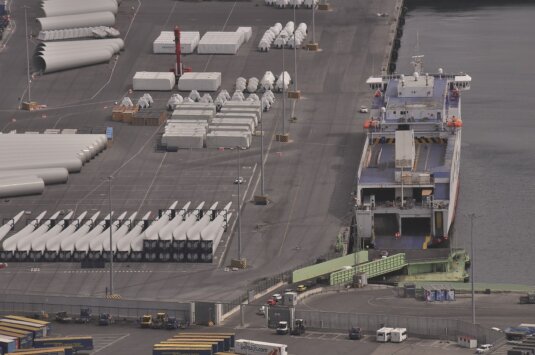The Port Authority of Bilbao has signed the European Wind Charter, thereby confirming, together with representatives of the European Commission, the Energy Ministers of 23 EU States and over 300 companies in the wind energy sector, its commitment to strengthening Europe’s wind energy sector.
As a signatory to the Charter, the Port Authority will collaborate in a coordinated effort with fellow signatory institutions and companies to improve the enabling conditions for the European wind industrial ecosystem, and to align and implement its actions with those of the European Commission, Member States and the wind sector, thereby demonstrating its commitment to drive and support the port’s customers in their efforts to address the challenges the energy transition poses and to promote this strategic activity in the port of Bilbao.
At present, Bilbao is home to two companies dedicated exclusively to this type of traffic: Haizea Wind, a wind power component manufacturer, and Siemens Gamesa Renewable Energy Eólica, which has its export hub in the port of Bilbao. Navacel has facilities along the Bilbao river that also enable it to manufacture these components and subsequently export them, while Nordex Acciona and other manufacturers with plants in the catchment area of the port of Bilbao also use the port for storage and important export and import operations. Other operators, such as stevedoring companies, also use the port for this type of traffic.
The Port Authority also collaborates with the port community and with companies and institutions in projects linked to sustainability, such as the DemoSATH floating wind turbine project of the companies Saitec Offshore Technologies and RWE Renewables. The floating platform for the turbine was assembled in the docks of the port of Bilbao and later towed to the BiMEP open sea test site in Armintza, Bizkaia, where it is now generating renewable electricity, with a view to testing its pre-stressed concrete components and the use of a single point mooring system for use in deep-water offshore wind farms.
Commitments of the signatory Member States
The institutions and companies who have signed the European Wind Charter commit to implementing the actions outlined in the Wind Energy Package published in October by the European Commission, which includes 15 immediate actions to strengthen the competitiveness of Europe’s wind value chain. A resilient, competitive and sustainable wind supply chain is required to double the current deployment rate and to provide security of supply, with a view to delivering the recently agreed EU target of at least 42.5% renewable energy by 2030, and with the ambition to reach the 45% figure set in the revised Renewable Energy Directive (RED), which will require a massive increase in EU wind installed capacity.

By signing the European Wind Charter, the Member States commit to urgently implement changes in the design and permitting of wind energy auctions, to invest in the European wind energy supply chain and to support the infrastructure required for wind energy expansion. They will also be required to rapidly implement the streamlined permitting rules under the new Renewable Energy Directive and to push deployment of the ICT needed for the digitisation of permitting processes; to make more use of pre-qualification criteria in critical areas such as cybersecurity to raise the bar on which turbines can be built in Europe; to ensure auction prices are indexed to reflect increases in input costs; and to improve long-term visibility by publishing clear auction schedules, and ten-year plans for the expansion of wind energy and a 2040 outlook, amongst other issues.
Likewise, the signatory Member States commit to unlock investments in Europe’s wind energy value chain, to make full use of the flexibility provided under the revised EU State Aid rules, and to ramp up the investments required in ports, roads and electricity grids to support the expansion of wind power. On grids, Member States are expected to implement the excellent measures set out in the recent EU Action Plan for Grids.

 Port access
Port access